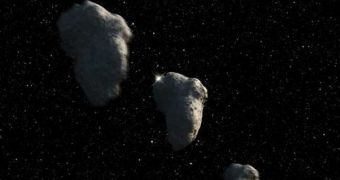While scanning our solar system's outer asteroid field, known as the Kuiper Belt, astronomers managed to make a very impressing find. They determined the existence of a very small space object among the debris, no more than one mile wide. This finding makes the rock the smallest one ever discovered in our Sun's vicinity, the experts say. The Kuiper Belt lies beyond the orbit of Neptune, and stretches for a considerable distance in outer space. The discovery was made using the refurbished Hubble Space Telescope, Space reports.
The truly remarkable aspect of this finding is the fact that the object was discovered via the light it reflected, and not in infrared wavelengths. The actual size of the space rock is of 3,200 feet (975 meters) across, the team that made the find reports. In terms of telescope resolution, this achievement represents a 30-fold improvement. The second smallest Kuiper Belt object was about 30 miles across. Astronomers believe that such small objects were comet-sized bodies once, but that, now, they are being constantly eroded through numerous, small collisions, and considerably reduced in size.
Another interesting find is the fact that the Belt's ice content appears to have been undergoing constant modifications for the past four billion years. This in turn means that some of the ice may have reached our planet aboard comets, which lends further credence to the newly proposed idea that most of the Earth's waters and atmosphere are extraterrestrial in origin. The new observations were detailed in a scientific paper, published in the December 17 issue of the esteemed journal Nature.
Because the space rock was about 100 times dimmer than what Hubble could see directly, the research team, based at the California Institute of Technology (Caltech) in Pasadena, used a trick of light to make the observations possible. They hypothesized that a very small body could be detected if it passed straight in front of a star, causing its brightness to change for a short time. This is the same principle that is used to detect exoplanets around distant stars. So the group used data collected by the telescope's Fine Guidance Sensors (FGS) as reference.
The FGS look at selected stars for creating a reference frame in navigating Hubble in the Earth's orbit. In all, the team gathered more than 12,000 hours of data, covering more than 50,000 stars. They were able to detect the minor occultation that was generated by the small rock in these data sets. The research was focused on the main plane of the solar system, where the Kuiper Belt was hypothesized to lie. The event that led to the discovery was very short, roughly lasting for 0.3 seconds.

 14 DAY TRIAL //
14 DAY TRIAL //